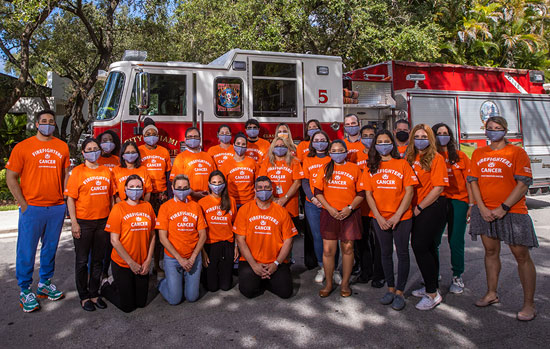Sylvester Comprehensive Cancer Center shares a story of a firefighter diagnosed with multiple myeloma discussing the risk of the disease among firefighters:
David Perez, a firefighter for 14 years in the North Collier Fire Control and Rescue in Naples, Florida, felt like he was in good health, but when lab test results were “off” after a routine physical, the doctor urged him to see a hematologist.
He eventually made his way to Sylvester Comprehensive Cancer Center, part of UHealth – the University of Miami Health System.
In early 2020, Perez was diagnosed with the blood cancer multiple myeloma. He underwent two years of intensive chemotherapy treatments, but then mantle cell lymphoma, another blood cancer, was diagnosed. The father of an 11-year-old daughter and an 8-year-old son is now six months out from a stem cell transplant received for the second cancer, and he is currently cancer-free.
‘I had an inkling that cancer was a big issue in the fire service, but I don’t have any cancer in my family, so I guess I decided to just keep my head buried in the sand,’ said Perez, 44. ‘I didn’t think it would affect me because I wasn’t predisposed to it. I definitely took my health for granted.’
Researchers at Sylvester’s Firefighter Cancer Initiative are working to increase screening for several types of cancer in firefighters. They also are conducting studies to better understand cancer risks in this population and how to lower those risks.
The initiative recently concluded its annual symposium, where experts from the cancer research and firefighting communities come together to talk about cancer risk.

Dr. C. Ola Landgren, chief of the Division of Myeloma and director of the Sylvester Myeloma Research Institute, has several related studies underway. He previously served at Memorial Sloan Kettering Cancer Center in New York and the National Institutes of Health’s National Cancer Institute, where he led large, collaborative studies investigating links between certain occupational exposures and multiple myeloma.
He began to see what looked like patterns. In New York, for example, he had three myeloma patients who lived on the same block on Staten Island, and their houses had been covered by dust after the World Trade Center towers fell in 2001.
‘Seeing these things as a doctor triggered me to think about it and see if we could bring some more clarity to the situation,’ Landgren said. ‘These were very patient-derived questions. Much of the time, science comes from these clinical observations.’
Multiple myeloma is often preceded by a precancerous condition known as monoclonal gammopathy of undetermined significance, or MGUS. Landgren’s studies showed higher levels of MGUS linked to pesticide use among farmers and exposure to Agent Orange among veterans of the Vietnam War. Levels also were higher in firefighters, police officers and construction workers who were on-site immediately after the World Trade Center towers collapsed in the 9/11 attacks.
Landgren is now co-leading a large study with Sylvester myeloma researcher, Dr. Dickran Kazandjian, looking at risks of multiple myeloma in military officers linked to burn pits, which were commonly used to burn trash on U.S. military bases during the Gulf War.
Besides environmental exposures, other demographic factors can increase the risk for multiple myeloma. Rates of this cancer are higher in men, Black people, older adults, obese people and those with a family history of myeloma. With external collaborators, Landgren is also co-leading a study investigating the risk of myeloma and MGUS in people with certain inherited immune disorders.
Because the cancer can develop decades after occupational exposure, unpacking the exact cause of the disease can be difficult, said Dr. Francesco Maura, an assistant professor at Sylvester and myeloma researcher who is investigating racial disparities in multiple myeloma.
‘According to our data, myeloma might take more than 20 or 30 years to develop,’ Maura said. ‘During this time, there might be a lot of other factors that come up that also influence cancer development, so we don’t know the full picture.’
Although there is not yet any established curative treatment for multiple myeloma, catching and treating the disease early can prevent some of its more serious complications, like broken bones from bone lesions, Maura said.
Perez, the Naples firefighter, initially kept his cancer diagnosis quiet, but a colleague mentioned Sylvester’s Firefighter Cancer Initiative and the associated Dolphins Challenge Cancer, a fundraising event for Sylvester run by the Miami Dolphins. Perez attended for the first time a few years ago. He’s returned every year since and presented a poster at the most recent FCI symposium. He said that coming to the events made him realize how large his community is.
‘My eyes really opened up as to how many firefighters have been diagnosed with cancer and how many people there are fighting for us,’ Perez said..

